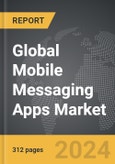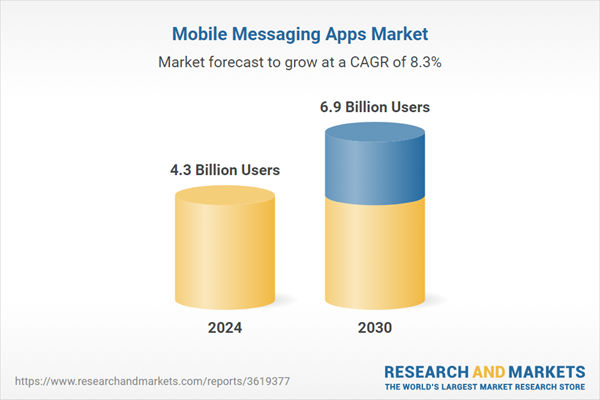The global market for Mobile Messaging Apps was sized at 4.3 Billion Users (Cumulative) in 2024 and is projected to reach 6.9 Billion Users (Cumulative) by 2030, growing at a CAGR of 8.3% over the analysis period 2024-2030. This comprehensive report provides an in-depth analysis of market trends, drivers, and forecasts, helping you make informed business decisions. The report includes the most recent global tariff developments and how they impact the Mobile Messaging Apps market.
For marketers, the rise of mobile messaging apps offers a prime opportunity to engage with audiences directly and personally. These platforms align well with shifts toward conversational marketing, which leverages the personal, immediate nature of messaging to enhance customer relationships. Unlike traditional marketing channels such as email, which may lack immediacy and personal touch, messaging apps allow for ongoing dialogues that boost customer engagement and loyalty. These interactions enable marketers to perform a variety of functions effectively, from sending service notifications to conducting real-time customer support and executing personalized promotions. The interactive nature of these platforms turns every conversation into a potential opportunity to reinforce brand loyalty and adapt marketing strategies based on direct feedback, thereby enhancing the effectiveness of marketing efforts and driving deeper customer engagement.
The proliferation of mobile messaging apps is shifting traditional marketing paradigms towards more interactive and engagement-driven strategies, underscoring the importance of two-way communication in achieving marketing success. Marketers are increasingly recognizing the necessity of adapting to this dynamic environment by leveraging mobile messaging apps to reach consumers who are more receptive and already engaged on these platforms. This engagement is not only about reaching an audience but involves creating meaningful interactions that foster stronger connections and more profound brand loyalty. Furthermore, the integration capabilities of messaging apps with CRM systems, their multi-agent functionality, and the potential for automation enhance operational efficiency, making them superior to traditional social networks for managing customer relations and maintaining business reputations. As digital communication continues to evolve, the strategic focus on mobile messaging apps is essential for marketers aiming to capitalize on this shift and foster an environment of enhanced interaction and customer satisfaction.
Segments: Segment (Mobile Messaging Apps).
Geographic Regions/Countries: World; United States; Canada; Japan; China; Europe (France; Germany; Italy; United Kingdom; Spain; Russia; and Rest of Europe); Asia-Pacific (Australia; India; South Korea; and Rest of Asia-Pacific); Latin America (Argentina; Brazil; Mexico; and Rest of Latin America); Middle East (Iran; Israel; Saudi Arabia; United Arab Emirates; and Rest of Middle East); and Africa.
The analysts continuously track trade developments worldwide, drawing insights from leading global economists and over 200 industry and policy institutions, including think tanks, trade organizations, and national economic advisory bodies. This intelligence is integrated into forecasting models to provide timely, data-driven analysis of emerging risks and opportunities.
Global Mobile Messaging Apps Market - Key Trends and Drivers Summarized
Mobile messaging apps have become a central fixture in modern communication, particularly reshaping how people interact in the digital age. These platforms, evolving from the novelty of SMS to the dynamic hubs of interaction they are today, have seen exponential growth, influencing not just personal communication but also how brands engage with consumers. Initially, texting was a costly service limited in usage, but as mobile plans evolved to offer unlimited texting, the adoption of mobile messaging apps like WhatsApp, Facebook Messenger, and Snapchat surged. These apps have broadened communication capabilities far beyond simple texts, incorporating multimedia sharing, live video, and group chats, making them integral to daily interactions for billions worldwide. This shift has not only led to a decline in traditional SMS but also marked a significant transformation in the communication landscape, highlighting the importance of these platforms in facilitating modern forms of interaction.For marketers, the rise of mobile messaging apps offers a prime opportunity to engage with audiences directly and personally. These platforms align well with shifts toward conversational marketing, which leverages the personal, immediate nature of messaging to enhance customer relationships. Unlike traditional marketing channels such as email, which may lack immediacy and personal touch, messaging apps allow for ongoing dialogues that boost customer engagement and loyalty. These interactions enable marketers to perform a variety of functions effectively, from sending service notifications to conducting real-time customer support and executing personalized promotions. The interactive nature of these platforms turns every conversation into a potential opportunity to reinforce brand loyalty and adapt marketing strategies based on direct feedback, thereby enhancing the effectiveness of marketing efforts and driving deeper customer engagement.
The proliferation of mobile messaging apps is shifting traditional marketing paradigms towards more interactive and engagement-driven strategies, underscoring the importance of two-way communication in achieving marketing success. Marketers are increasingly recognizing the necessity of adapting to this dynamic environment by leveraging mobile messaging apps to reach consumers who are more receptive and already engaged on these platforms. This engagement is not only about reaching an audience but involves creating meaningful interactions that foster stronger connections and more profound brand loyalty. Furthermore, the integration capabilities of messaging apps with CRM systems, their multi-agent functionality, and the potential for automation enhance operational efficiency, making them superior to traditional social networks for managing customer relations and maintaining business reputations. As digital communication continues to evolve, the strategic focus on mobile messaging apps is essential for marketers aiming to capitalize on this shift and foster an environment of enhanced interaction and customer satisfaction.
Report Scope
The report analyzes the Mobile Messaging Apps market, presented in terms of units. The analysis covers the key segments and geographic regions outlined below.Segments: Segment (Mobile Messaging Apps).
Geographic Regions/Countries: World; United States; Canada; Japan; China; Europe (France; Germany; Italy; United Kingdom; Spain; Russia; and Rest of Europe); Asia-Pacific (Australia; India; South Korea; and Rest of Asia-Pacific); Latin America (Argentina; Brazil; Mexico; and Rest of Latin America); Middle East (Iran; Israel; Saudi Arabia; United Arab Emirates; and Rest of Middle East); and Africa.
Regional Analysis
Gain insights into the U.S. market, sized at 1.1 Billion Users (Cumulative) in 2024, and China, forecasted to grow at an impressive 12.8% CAGR to reach 1.8 Billion Users (Cumulative) by 2030. Discover growth trends in other key regions, including Japan, Canada, Germany, and the Asia-Pacific.Why You Should Buy This Report:
- Detailed Market Analysis: Access a thorough analysis of the Global Mobile Messaging Apps Market, covering all major geographic regions and market segments.
- Competitive Insights: Get an overview of the competitive landscape, including the market presence of major players across different geographies.
- Future Trends and Drivers: Understand the key trends and drivers shaping the future of the Global Mobile Messaging Apps Market.
- Actionable Insights: Benefit from actionable insights that can help you identify new revenue opportunities and make strategic business decisions.
Key Questions Answered:
- How is the Global Mobile Messaging Apps Market expected to evolve by 2030?
- What are the main drivers and restraints affecting the market?
- Which market segments will grow the most over the forecast period?
- How will market shares for different regions and segments change by 2030?
- Who are the leading players in the market, and what are their prospects?
Report Features:
- Comprehensive Market Data: Independent analysis of annual sales and market forecasts in US$ Million from 2024 to 2030.
- In-Depth Regional Analysis: Detailed insights into key markets, including the U.S., China, Japan, Canada, Europe, Asia-Pacific, Latin America, Middle East, and Africa.
- Company Profiles: Coverage of players such as Alibaba Group, Apple Inc., BlackBerry Limited, Facebook Inc., Google Inc. and more.
- Complimentary Updates: Receive free report updates for one year to keep you informed of the latest market developments.
Some of the 119 companies featured in this Mobile Messaging Apps market report include:
- Alibaba Group
- Apple Inc.
- BlackBerry Limited
- Facebook Inc.
- Google Inc.
- Hike Ltd.
- Kakao Corp.
- Kik Interactive Inc.
- LINE Corporation
- Snap Inc.
- Tango
- Telegram Messenger LLP
- Tencent Holdings
- Viber Media S.à r.l
- WhatsApp Inc.
Tariff Impact Analysis: Key Insights for 2025
Global tariff negotiations across 180+ countries are reshaping supply chains, costs, and competitiveness. This report reflects the latest developments as of April 2025 and incorporates forward-looking insights into the market outlook.The analysts continuously track trade developments worldwide, drawing insights from leading global economists and over 200 industry and policy institutions, including think tanks, trade organizations, and national economic advisory bodies. This intelligence is integrated into forecasting models to provide timely, data-driven analysis of emerging risks and opportunities.
What’s Included in This Edition:
- Tariff-adjusted market forecasts by region and segment
- Analysis of cost and supply chain implications by sourcing and trade exposure
- Strategic insights into geographic shifts
Buyers receive a free July 2025 update with:
- Finalized tariff impacts and new trade agreement effects
- Updated projections reflecting global sourcing and cost shifts
- Expanded country-specific coverage across the industry
Table of Contents
I. METHODOLOGYII. EXECUTIVE SUMMARY2. FOCUS ON SELECT PLAYERSIII. MARKET ANALYSISIV. COMPETITION
1. MARKET OVERVIEW
3. MARKET TRENDS & DRIVERS
4. GLOBAL MARKET PERSPECTIVE
UNITED STATES
CANADA
JAPAN
CHINA
EUROPE
FRANCE
GERMANY
ITALY
UNITED KINGDOM
SPAIN
RUSSIA
REST OF EUROPE
ASIA-PACIFIC
AUSTRALIA
INDIA
SOUTH KOREA
REST OF ASIA-PACIFIC
LATIN AMERICA
ARGENTINA
BRAZIL
MEXICO
REST OF LATIN AMERICA
MIDDLE EAST
IRAN
ISRAEL
SAUDI ARABIA
UNITED ARAB EMIRATES
REST OF MIDDLE EAST
AFRICA
Companies Mentioned (Partial List)
A selection of companies mentioned in this report includes, but is not limited to:
- Alibaba Group
- Apple Inc.
- BlackBerry Limited
- Facebook Inc.
- Google Inc.
- Hike Ltd.
- Kakao Corp.
- Kik Interactive Inc.
- LINE Corporation
- Snap Inc.
- Tango
- Telegram Messenger LLP
- Tencent Holdings
- Viber Media S.à r.l
- WhatsApp Inc.
Table Information
| Report Attribute | Details |
|---|---|
| No. of Pages | 312 |
| Published | April 2025 |
| Forecast Period | 2024 - 2030 |
| Estimated Market Value in 2024 | 4.3 Billion Users |
| Forecasted Market Value by 2030 | 6.9 Billion Users |
| Compound Annual Growth Rate | 8.3% |
| Regions Covered | Global |









